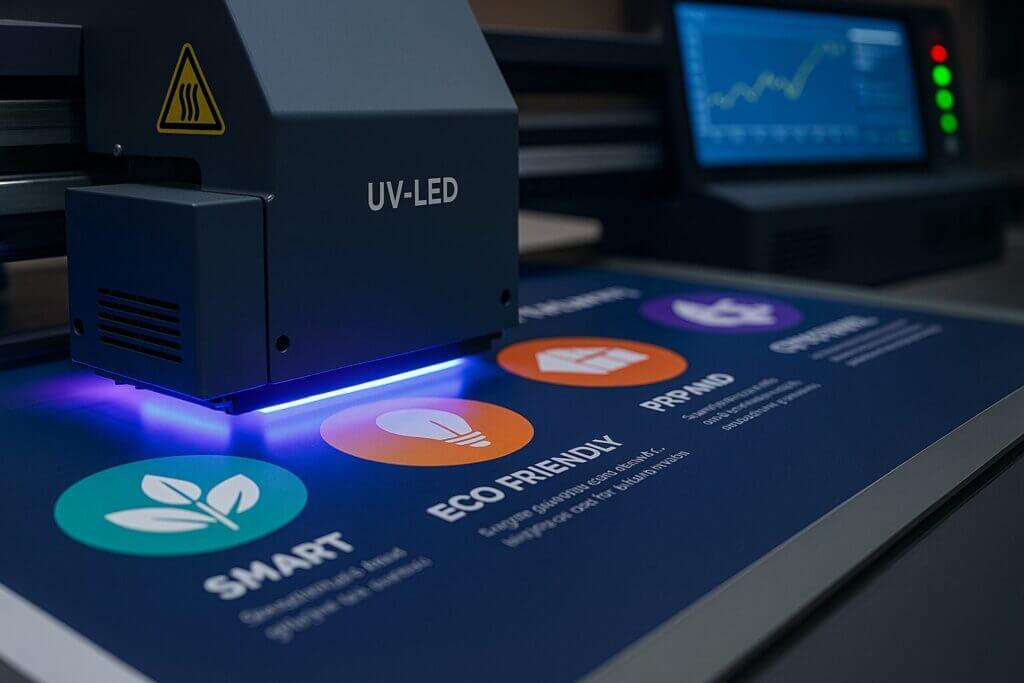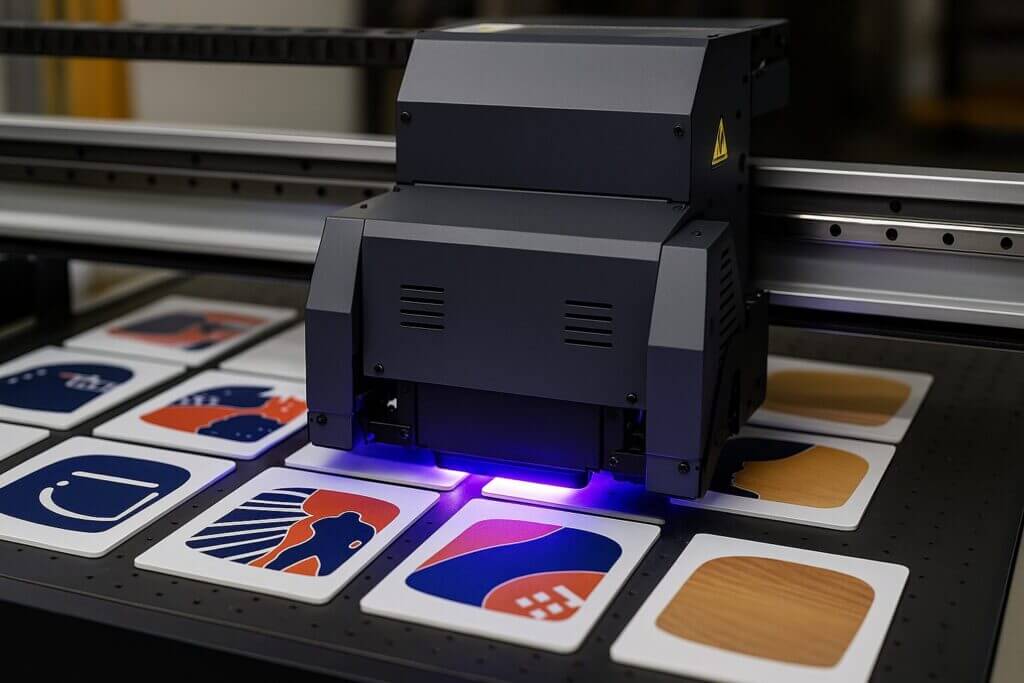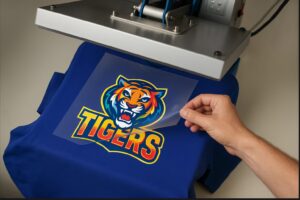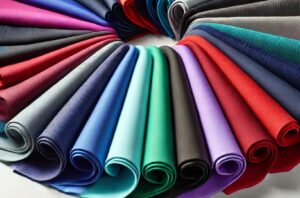UV printing is a term popping up more and more in across industries from retail to manufacturing, but what exactly does it mean? This guide explains the process, where it’s commonly used, and how to decide if it’s the right fit for your business.
In this guide, we’ll break down how UV printing works, explore its common uses, and look at whether it makes sense for your business.
What Is UV Printing?
UV printing is a digital printing process that uses ultraviolet light to instantly cure ink as it’s applied to a surface. Unlike traditional printing methods, there’s no need for heat or drying time, which makes the process faster and more efficient.
This technology allows printing on a wide variety of materials, including wood, glass, metal, plastic, leather, and acrylic. The ability to print directly onto these surfaces, combined with the option to use white ink for dark or transparent items, makes UV printing highly versatile for both small and large-scale projects.
One of the biggest advantages of UV printing is the quality and durability of the results. The cured inks produce sharp details, vibrant colors, and a smooth finish that resists fading, scratching, and water damage. This makes it ideal for custom products, promotional items, packaging prototypes, signage, and personalized items like phone cases or drinkware. Since the process is digital, it’s also cost-effective for short runs or one-off projects, as it doesn’t require screens, plates, or setup like traditional methods.
However, UV printing has its limitations and costs to consider. The equipment and inks are expensive compared to other printing technologies, with machines ranging from a few thousand dollars for small desktop units to over $30,000 for industrial models. It also struggles with highly curved surfaces and may require surface preparation for certain materials.
Maintenance is another factor, as print heads and UV lamps need regular care to ensure consistent results. Despite these challenges, its flexibility, speed, and high-quality output make UV printing a powerful tool for businesses seeking customization and fast turnaround.
How UV Printing Works
UV printing uses a combination of specialized software, UV-reactive ink, and light-curing technology to produce high-quality prints on a wide range of surfaces.
Step 1: Prepare Your Design in RIP Software
Before printing, your design file (such as a PDF or vector graphic) is loaded into RIP (Raster Image Processor) software. RIP software controls how the image will be printed, including color accuracy, ink layering, and the use of white ink or gloss varnish.
Popular RIP software includes FlexiPRINT, Onyx, and Caldera. Many UV printers come with a version pre-installed or bundled. Most settings are handled during setup, but complex designs may require manual adjustments.
Step 2: The Print Head Applies UV Ink
The design is sent to the printer, which uses a piezoelectric print head to spray ink onto the material. These heads eject precise droplets of ink using electric pulses. Brands like Epson or Ricoh often supply the print heads used in UV printers.
UV ink is thicker than traditional inks and designed to stick to non-porous surfaces such as glass, acrylic, coated metal, or plastic. Some materials, especially smooth ones like glass or metal, may need a primer for better adhesion.
Step 3: UV Lamp Cures the Ink Instantly
As the print head moves across the surface, a UV LED lamp follows closely behind. The lamp exposes the ink to ultraviolet light immediately after it lands on the surface. This quick exposure starts the curing process while the printing is still in progress.
Step 4: Photoinitiators Harden the Ink
UV ink contains photoinitiators, special chemicals that react to UV light. When exposed, they trigger a rapid chemical reaction that hardens the ink into a solid layer. This process happens within seconds, leaving no drying time.
Step 5: Print Is Ready for Handling or Packaging
Once cured, the ink is dry, durable, and fully bonded to the surface. This allows items to be handled or packed right away without smudging or damage. UV prints are resistant to scratches and fading, making them suitable for both indoor and outdoor use.
Is UV Printing Right for Your Product?
UV printing offers clear advantages when you’re working with rigid surfaces and need fast, detailed output. However, it is not the best fit for every application. Below are examples of when it works well and where you might want to consider other methods.
Branded Merchandise & Custom Orders
UV printing is a strong choice for customizing items like phone cases, drinkware, keychains, pens, and promo kits. It allows you to print directly onto flat or cylindrical surfaces (using a rotary attachment), making it well suited for mixed batches such as event giveaways, staff gifts, or limited-edition products.
Instead of applying vinyl labels, which can bubble or peel over time, UV printing produces a direct-to-surface finish that saves time and offers better durability.
However, it is not suitable for soft or flexible items like apparel or silicone. Once cured, UV ink becomes rigid and may crack if the surface bends or stretches.
Product Packaging & Prototypes
Many boutique and direct-to-consumer brands use UV printing to add logos, product details, or full-color designs directly onto boxes, sleeves, or plastic containers. This approach eliminates the need for separate label application and works especially well for small runs or packaging prototypes that change frequently.
You can revise your artwork between runs without additional tooling or setup costs. For large-volume packaging with fixed artwork, though, offset or flexographic printing methods may be more cost-effective.
Signage & Visual Displays
UV printing produces sharp, vibrant graphics on rigid signage materials such as acrylic, foam board, PVC, and coated metal. It is commonly used for retail displays, in-store signage, window graphics, and even outdoor signs due to its fade- and scratch-resistant finish.
It is a great option for short-term promotions or frequently updated visuals where image quality and durability are important.
Most flatbed UV printers can handle signage up to approximately 5 feet by 10 feet (1.5 meters by 3 meters).
For projects that exceed that size, you may need to print in multiple panels and assemble them afterward. If you need long-format flexible signage like banners, roll-to-roll UV printers are a better fit, although they only work on materials such as vinyl or mesh.
What Surfaces Work Best?
Not every material works well with UV printing. Because UV ink cures on top of the surface rather than absorbing into it, the texture and finish of your product directly affect how well the ink bonds. Smooth, rigid, and non-absorbent materials like acrylic and coated paperboard tend to deliver the best results.
Even products made from similar materials can behave differently depending on surface coatings or finishes. For example, one type of PET plastic may print well right away, while another with a glossy or treated surface might require pre-treatment.
The same applies to glass, metal, and other rigid materials. If your product includes a mix of components, such as a silicone lid on a metal container, focus your printing only on compatible parts or consult your supplier for alternatives. Always clean surfaces thoroughly before printing, and when in doubt, run a test print to avoid unexpected issues.
UV printing compatibility breakdown by material
Below is a quick reference guide showing how different materials perform with UV printing and whether pre-treatment is typically required.
| Material | UV Compatibility | Pre-Treatment Needed? | Common Use Cases |
|---|---|---|---|
| Acrylic | Excellent | No | Signage, awards, photo panels, displays |
| Paperboard (coated) | Excellent | No | Luxury boxes, folding cartons, rigid packaging |
| Coated glass | Good | Yes | Trophies, branded décor, signage |
| Metal (e.g. aluminum) | Good | Often (especially outdoors) | Nameplates, custom tins, industrial labels, packaging lids |
| Plastics (ABS, PET, PVC) | Good | Sometimes | Promo items, containers, electronics casing |
| Ceramic | Good | Yes | Tiles, coasters, custom drinkware |
| Wood (smooth or sealed) | Moderate | Recommended | Gifts, signs, packaging inserts |
| Uncoated wood/cardboard | Low | Yes (sealer recommended) | May absorb ink and cause dull or uneven results |
| Rubber or silicone | Poor | Yes (special inks required) | Ink struggles to bond; not recommended for standard use |
| Stretchy or soft fabric | Not compatible | — | Ink cracks or peels when material moves or stretches |
If you’re unsure whether UV printing is a good match for your product, ask your supplier or printing partner to run a sample on your actual material. This helps confirm print quality, adhesion, and overall finish before committing to a full production run.
Pros and Cons of UV Printing
Like any printing method, UV printing has its strengths and limitations. Below is a quick breakdown to help you decide if it’s the right fit for your needs.
Pros of UV Printing
UV printing offers several key benefits that make it a strong option for product makers, packaging teams, and custom brands. Here’s what stands out the most:
1. Instant drying
UV ink cures immediately when exposed to ultraviolet light, so there’s no need for drying racks or extended wait times. This not only speeds up production but also reduces the floor space required for staging printed items.
Compared to traditional methods like screen printing or inkjet printing, where prints might need 30 minutes to several hours to dry, UV printing allows you to move directly to cutting, folding, or packaging. That can save several square meters of workspace and eliminate the need to batch jobs by drying stage.
2. High-Quality Detail
What makes UV printing stand out is how it delivers clean lines, sharp edges, and vibrant color directly onto rigid surfaces. Most UV printers offer print resolutions between 600 and 1,200 DPI. Some high-end models reach up to 1,440 DPI, more than enough to reproduce photo-quality images and subtle gradients without bleeding or blurring.
It can also print very small text, as small as 1.5 to 2 millimeters tall, without losing clarity. That makes it ideal for product details, batch codes, and QR codes that need to scan accurately. For brands printing directly onto packaging, promotional items, or custom merchandise, this level of precision lets you skip adhesive labels while still achieving a clean, professional finish.
3. Eco-Friendly
Unlike solvent printing, which releases volatile organic compounds (VOCs) into the air as the ink dries, UV printing uses low-VOC inks that cure instantly under UV light without a toxic smell. VOC emissions from solvent-based printers can exceed 300g/m², while UV inks often stay below 50g/m², depending on the formulation.
When paired with LED curing systems, UV printing also consumes significantly less energy. LED lamps can use up to 70% less electricity than traditional heat-based UV lamps, which reduces cooling needs and extends lamp lifespan by as much as 10 times. Many UV inks and LED systems are also designed to meet environmental standards such as REACH and RoHS, helping brands stay compliant with global sustainability regulations and reduce their overall chemical footprint.
Cons of UV Printing
Despite its advantages, UV printing is not ideal for every situation. The following challenges are worth considering before investing in equipment or switching from another print method.
1. Higher Upfront Investment
Getting started with UV printing requires a significant investment, especially compared to other printing methods. A compact UV printer typically starts between $5,000 and $10,000. Mid-size flatbed machines often exceed $30,000. That’s before factoring in the cost of UV ink, RIP software, maintenance kits, or calibration tools.
On top of that, UV ink can run $100–$300 per liter. You’ll also need cleaning supplies, spare parts, and time for staff training. For small businesses or low-volume operations, it can take a year or more of consistent output just to break even.
Because of these costs, it’s often smarter to work with a local UV printing partner for samples or short production runs. This approach gives you a chance to test materials, pricing, and market demand before investing heavily in equipment.
2. Higher Maintenance Costs
UV printers require much more regular maintenance than other types of printers. Skipping it can quickly lead to expensive problems. Because UV ink cures fast, it can start to harden inside the nozzles if the printer sits idle for even a short time. This causes clogs that result in streaks, color dropouts, or full head failures that may cost thousands to fix.
If you don’t print daily or forget routine cleaning, your printer might stop working when you need it most. Even basic upkeep like automatic cleanings or daily test prints uses up ink. Many machines consume 5–10 ml of ink per cleaning cycle, which adds up to $50–$100 a month or more, depending on the printer and ink brand.
Some models include features like ink circulation or sealed capping stations to reduce buildup, but not all do. Either way, owning a UV printer means committing to a maintenance routine, daily, not weekly or risking serious damage.
3. Strong Odor in Enclosed Spaces
UV inks are safer than traditional solvent-based inks, but they can still produce a noticeable chemical smell during printing. The odor is stronger when using white or varnish inks, which require thicker layers and more curing agents. These smells come from trace byproducts like photoinitiators and monomers released during the UV curing process.
Even though UV inks are classified as low-VOC, they’re not odor-free. In well-ventilated spaces, VOC levels typically stay below 5 parts per million (ppm), with minimal discomfort. But in enclosed areas, levels can rise to 20–30 ppm during continuous printing, enough to cause mild irritation, headaches, or nausea for some people. Symptoms may start at around 10 ppm depending on sensitivity and exposure time.
To avoid these issues, UV printers should always be used in well-ventilated areas. Small businesses often install exhaust fans or carbon filters, especially when operating in compact offices.

UV Printing vs DTG and Sublimation
Not sure which printing method is right for your product? This comparison cuts through the noise, helping you quickly decide whether UV, DTG, or sublimation fits your material, budget, and workflow.
UV Printing
UV printing is best known for its ability to print on hard, non-porous surfaces, something DTG and sublimation cannot do. While those methods are limited to fabrics or coated materials, UV allows direct printing onto items like acrylic signs, metal tins, and plastic packaging. It also works on dark or transparent materials without the need for a white base layer or specialized coatings. These advantages make UV printing a strong choice for customized merchandise, rigid packaging, and short-run product decoration where flexibility and fast turnaround matter most.
DTG Printing
DTG (Direct-to-Garment) printing is designed for natural fabrics, especially 100% cotton. It uses water-based pigment ink that absorbs into fabric fibers and is then cured using a heat press or conveyor dryer at around 320°F (160°C). Most DTG printers deliver resolutions of 1,200 × 1,200 DPI or higher, allowing for full-color, photo-realistic designs.
The soft hand feel of DTG prints is a key selling point, making it popular for fashion apparel and custom T-shirts. However, it is typically slower than other methods—printing one shirt can take 3 to 6 minutes. It is limited to flat garments. Pretreatment is also required when printing on dark fabrics to ensure opacity and durability.
DTG works best for low- to mid-volume runs of custom apparel. For example, a small DTG printer may produce around 20 to 30 shirts per hour, depending on print size and complexity. It is not suitable for hard surfaces or synthetic fabrics like polyester, which do not absorb the ink effectively.
Sublimation Printing
Sublimation printing uses heat and pressure to turn dye into gas, which then bonds with polyester fibers or polyester-coated surfaces at a molecular level. The process typically requires a heat press at 380–400°F (193–204°C) and produces vibrant, permanent prints that won’t crack, fade, or peel.
Sublimation excels in applications like sportswear, mugs, phone grips, and personalized gifts. However, it only works on white or light-colored surfaces and requires materials to be at least 65% polyester for optimal results. Dye-sublimation printers often print at 1,200 × 1,200 DPI and are especially valued for their speed and print consistency. It makes them a top choice for customized mugs, tiles, and polyester flags.
| Feature | UV Printing | DTG Printing | Sublimation |
| Best for | Hard surfaces, packaging, promo items | Cotton garments and soft apparel | Polyester fabric and coated gift items |
| Ink type | UV-curable ink | Water-based ink | Dye-sublimation ink |
| Surface type | Rigid, non-absorbent surfaces | Soft, absorbent fabrics | Polyester or polyester-coated surfaces |
| Material color | Any color, including dark or clear | Light and dark garments | Light-colored materials only |
| Drying process | Instant curing with UV light | Heat press or tunnel dryer required | Heat transfer using high temperature |
| Durability | Scratch- and fade-resistant | Good, but may fade with repeated washing | Highly durable and permanent on polyester |
If you’re focused on hard goods or packaging, UV printing offers the most flexibility. If you’re printing apparel or polyester products, DTG and sublimation are better suited.
How to Get Started with UV Printing
Ready to try UV printing but not sure where to begin? This section will walk you through the key decisions: whether to print in-house or outsource, what to expect from entry-level machines, and how to find a reliable manufacturer if you decide to work with a partner.
Is In-House UV Printing a Good Fit for You?
Bringing UV printing in-house can give you more control over turnaround time, branding quality, and production flexibility. But only if your business has the right setup and demand. As a general rule, in-house printing becomes cost-effective when you’re producing at least 200 to 500 units per month. This volume helps offset equipment costs (which often start at $8,000 for desktop units and can exceed $30,000 for flatbeds), along with ongoing ink and maintenance expenses.
It’s also a good option if you’re frequently customizing rigid materials like acrylic, coated packaging, or metal signage, and if you have the ventilation and workspace to support the equipment. A basic compact printer setup typically requires at least 2–4 square meters of space and stable airflow.
However, in-house UV printing may not be the best fit if:
- Your monthly volume is below 100 units, as maintenance cycles can use more ink than production
- You don’t have dedicated staff to maintain print heads, manage color settings, or troubleshoot issues
- Your product line includes soft, flexible, or curved materials that UV printers cannot handle without custom jigs or surface treatments
If you’re still validating demand or working through early-stage product development, it often makes more sense to outsource a few jobs first. This lets you test real materials and designs without committing to equipment, giving you a clearer picture of the ROI before going in-house.
Entry-Level UV Printers
If you’re ready to bring UV printing in-house, there are several compact, entry-level machines designed for small-scale production. These printers typically range from $5,000 to $15,000 and are suitable for printing on flat, rigid items such as phone cases, product boxes, signage, acrylic panels, and custom merchandise.
At this price point, most machines offer print areas between A4 and A3+ sizes, LED curing technology, and support for CMYK and white inks. Some also include clear varnish for spot gloss effects. Print resolutions often reach up to 1,200 DPI, which is sufficient for sharp logos, text, and fine detail.
When evaluating options, look for:
- LED UV curing (energy-efficient, low heat, and long lamp life of up to 10,000 hours)
- White ink capability (for printing on dark or transparent materials)
- Built-in ink circulation and nozzle maintenance systems (reduces clogging risk)
- Supported print height (typically 2–6 inches, depending on model)
- RIP software compatibility (essential for layout control, color profiling, and multi-layer printing)
Consumables and maintenance costs should also be considered. UV ink for these machines typically costs $100–$250 per liter, and daily cleaning routines may use 5–10 ml of ink per cycle.
3 Entry-Level UV Printers Worth Considering
| Model | Price Range | Print Area | Key Features |
|---|---|---|---|
| Mimaki UJF-3042 MkII | $12,000–$15,000 | 11.8″ × 16.5″ | 1,200 DPI, CMYK+White+Clear, 6-inch media height, trusted industrial brand |
| Roland VersaUV LEF2-200 | $10,000–$13,000 | 12″ × 20″ | White/clear ink, quick setup, auto-cleaning, strong US dealer support |
| Mutoh XpertJet 461UF | $8,000–$10,000 | 13″ × 19″ | Compact footprint, ink circulation system, affordable entry point |
Note: Pricing may vary by region and distributor. Always confirm if the purchase includes RIP software (such as Roland VersaWorks or RasterLink), training, and essential maintenance tools.
Finding a UV Printing Manufacturer
If you’re outsourcing UV printing, focus on suppliers with proven experience printing on your specific material and product type. For overseas sourcing, platforms like Alibaba, Made-in-China, and GlobalSources offer factory-direct access to manufacturers. Look for low MOQs (under 100 units), LED curing capabilities, and clear sample policies.
For faster turnaround or in-person collaboration, local trade printers and promotional product suppliers often offer UV printing for signage, packaging, and hard goods. If you’re testing eCommerce products, print-on-demand platforms like Printify or Gooten are ideal for short runs without inventory.
Wherever you source, confirm they support your material type (e.g., acrylic, coated cardboard, metal), offer at least 600–1,200 DPI print resolution, and provide printed samples before full production. Good communication and willingness to handle small batches are also key when starting out.
Is UV Printing Right for You?
UV printing is a fast, high-quality option for customizing rigid materials like packaging, signage, and branded merchandise. It’s ideal for short runs, clean detail, and premium finishes, especially when you want your product to stand out without switching materials.
At Sphere Sport, we collaborate with trusted production partners to deliver consistent branding across your entire product presentation, from hang tags and packaging to promotional items.
If you’re exploring how UV printing fits into your product or packaging workflow, contact us for practical advice tailored to your goals, materials, and budget.






